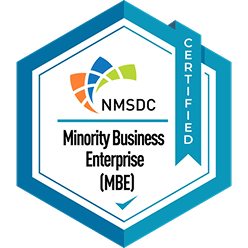
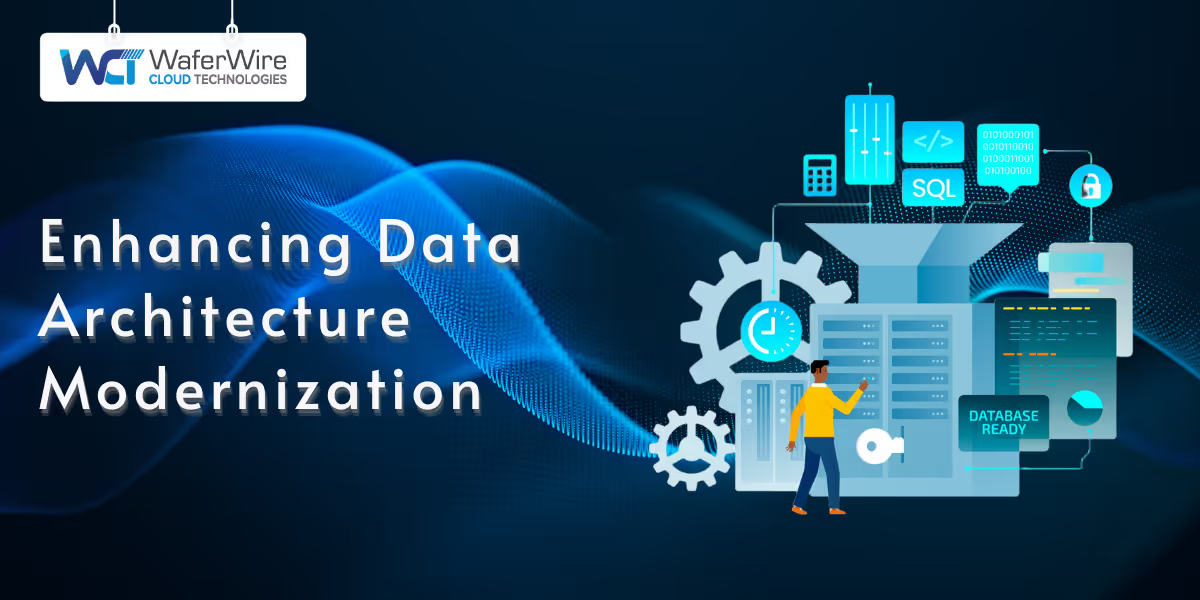
Data architecture modernization is a crucial step for businesses aiming to maximize the value of their data and future-proof their operations. As data volumes grow exponentially, outdated systems often limit an organization’s ability to manage and extract insights effectively. Transitioning to a modern, flexible, and scalable data architecture improves accessibility, streamlines workflows, and fosters innovation across teams.
This transformation empowers businesses to make timely, well-informed decisions that drive strategic goals. In this guide, we delve into the importance of modernizing data architecture, explore its key components, and outline best practices for seamless implementation.
Modernizing data architecture is essential for organizations that want to optimize their data resources and keep pace with technological advancements. By updating your data systems, you lay the groundwork for efficient data management, better decision-making, and business growth.
A modernized data architecture allows businesses to use data as a competitive advantage. It provides scalable, efficient systems that support faster decision-making and innovation. By leveraging advanced architectures, businesses can gain deeper insights, enhance customer experiences, and streamline operations, keeping them ahead of competitors. This approach helps organizations make the most of their data, driving growth and enabling them to adapt quickly to changing market demands.
While modernizing data architecture brings numerous benefits, it often involves overcoming significant challenges. Companies must address legacy system integration, data silos, and ensuring data security. Despite these obstacles, modernizing data architecture creates a more agile, scalable system that meets future business needs.
Modern architectures make data more accessible, organized, and actionable, enabling faster and more accurate decision-making. With high-quality data at hand, businesses can reduce risks and improve performance by relying on real-time insights.
Now that we've established the importance of modernizing your data architecture, let’s dive into the key components that make up a modern data architecture.
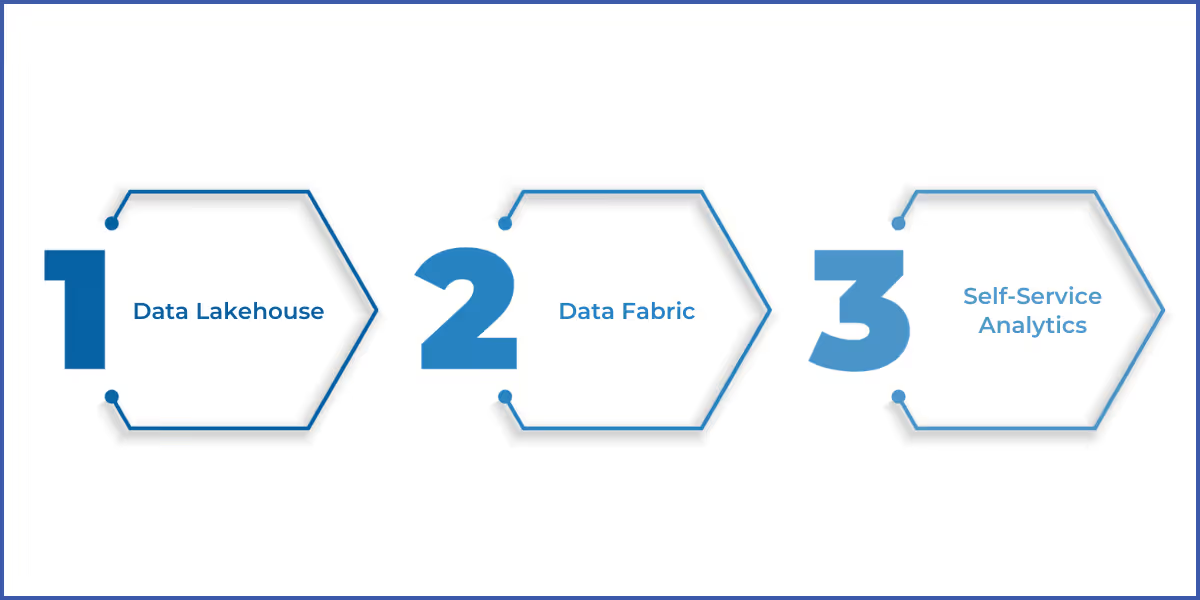
The key components of a modern data architecture are designed to work together to support scalable, flexible, and efficient data operations.
A data lakehouse combines the scalability of data lakes with the reliability of data warehouses. It allows organizations to store large volumes of raw, unstructured data while supporting advanced analytics and business intelligence. This hybrid model provides a single, unified platform for storing and analyzing both structured and unstructured data.
Data fabric connects disparate data sources, ensuring that data can be easily accessed across platforms. By integrating various data systems into a cohesive structure, data fabric breaks down silos, enabling organizations to make data more accessible to users across departments.
Self-service analytics tools give business users the ability to explore data, create reports, and generate insights without needing deep technical expertise. This not only reduces dependency on IT teams but also fosters a culture of data-driven decision-making within the organization.
With the key components outlined, let’s explore the core pillars that guide a modern data architecture’s effectiveness.
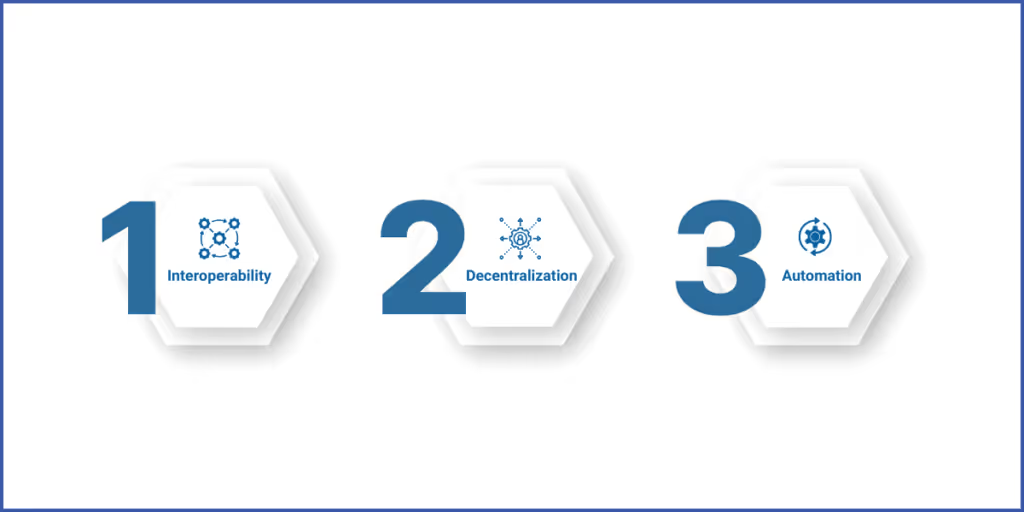
Modern data architecture is built on several fundamental pillars that ensure its scalability, flexibility, and efficiency in handling complex data operations.
Interoperability ensures that different data systems and platforms can work together seamlessly. By standardizing data integration practices, businesses can ensure that data flows smoothly across different environments, from on-premise systems to cloud-based platforms.
Decentralization involves distributing data ownership across different business units, which is the core concept behind a data mesh. This approach allows each department to manage its data independently while ensuring that the data is available across the organization for seamless collaboration and insights.
Automation is key to modern data architectures, as it ensures that repetitive data processes are handled efficiently. Automated workflows can help reduce human error, increase speed, and enhance the overall reliability of data systems, making them more adaptable and scalable.
Now that we’ve covered the pillars of modern data architecture, let’s take a look at the challenges organizations face when trying to modernize their data infrastructure.
Modernizing data architecture presents several challenges that organizations must navigate to ensure successful implementation.
To successfully modernize your data architecture, a well-defined framework is crucial. This structured approach minimizes disruption and ensures long-term value. Here’s a step-by-step guide:
Implementing best practices during your data architecture modernization journey can help minimize risks and maximize the return on investment.
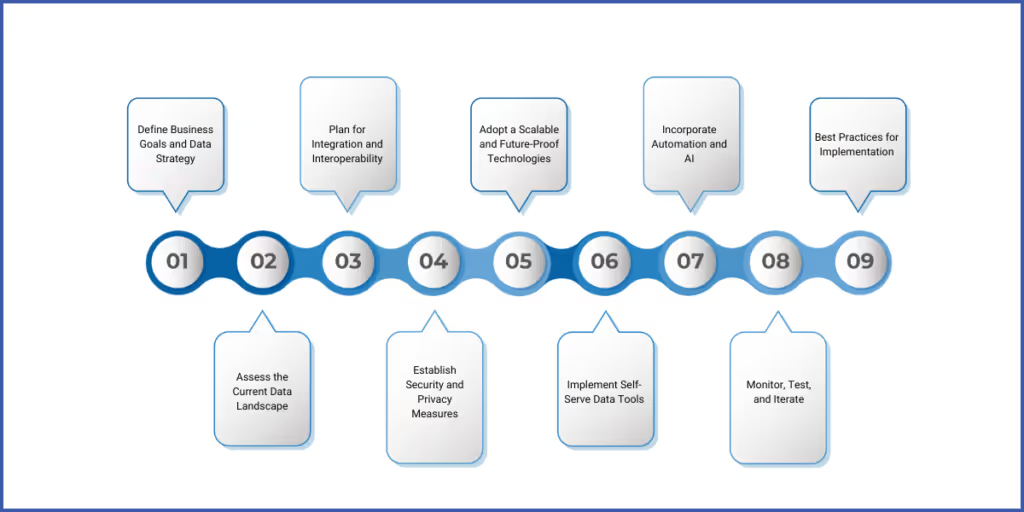
Implementing a modern data architecture requires careful planning and execution. By following a structured approach, organizations can ensure a smooth transition and successful implementation.
Before embarking on a modernization journey, it’s essential to define clear business goals and a data strategy. Understanding how your data architecture aligns with your broader business objectives will help guide the design and implementation of the new architecture.
A thorough assessment of your existing data systems and infrastructure is necessary to identify gaps, weaknesses, and opportunities for improvement. This assessment will inform the decisions you make regarding technology investments and integration efforts.
Ensure that your new data architecture is designed for easy integration with existing systems. Focus on creating an interoperable environment that allows data to flow seamlessly across platforms.
As data architectures evolve, it’s essential to implement robust security and privacy measures. This will ensure that sensitive data is protected and that your organization remains compliant with regulations.
Choose technologies that grow with your organization. Cloud-native solutions, containerization, and serverless architectures are great options for ensuring scalability and flexibility. These technologies allow you to respond to evolving demands without overhauling your infrastructure.
Provide teams with self-serve tools that enable them to access, analyze, and use data without heavy reliance on IT. Tools for data cataloging, visualization, and pipeline management can empower teams to derive insights independently, promoting a culture of data-driven decision-making.
Modern data architectures thrive on automation and artificial intelligence (AI). Automate data ingestion, transformation, and quality checks to reduce manual intervention and improve efficiency. For example, leveraging machine learning for anomaly detection in data pipelines can help address issues proactively.
Post-implementation, it’s critical to establish robust monitoring mechanisms. Leverage tools for real-time analytics, anomaly detection, and system optimization. Set key performance indicators (KPIs) to evaluate the success of your modernization efforts, such as improved query times, reduced downtime, and cost savings.
By following these steps and adopting best practices, organizations can transition to a modern data architecture that is not only robust and scalable but also adaptable to future needs.
Finally, let’s explore some considerations for selecting the right modern data architecture based on your organization’s needs.
Choosing the right modern data architecture requires careful consideration to align it with your business goals, operational needs, and long-term growth plans. The selected architecture should empower your organization to manage and leverage data efficiently while supporting scalability, innovation, and informed decision-making. Begin by analyzing your current systems to pinpoint gaps, identify opportunities for integration, and determine the best path for modernization. A thorough evaluation ensures a smoother transition and improved adaptability as your organization evolves.
Additionally, modernizing data architecture entails investments in cutting-edge technologies and building a skilled workforce. Evaluate tools that cater to your unique needs, such as data lakehouses, data fabric, or self-service analytics, and ensure your team is equipped with the expertise to implement and maintain them effectively. By balancing technology upgrades with talent development, your organization can establish a future-proof data infrastructure capable of driving sustainable growth and maximizing the value of its data assets.
Modernizing your data architecture is essential for staying competitive, driving innovation, and unlocking growth opportunities. By adopting modern frameworks like data lakehouses, data fabric, and self-service analytics, you can create an agile, scalable, and future-ready data infrastructure. A structured approach that includes overcoming challenges, implementing best practices, and aligning modernization efforts with business goals ensures long-term success.
WaferWire’s expertise in modernizing data architectures for its clients highlights the importance of a tailored approach to ensure successful outcomes. Data architecture modernization isn’t just about adopting new technologies; it’s about empowering your organization to make smarter decisions and drive growth.
Ready to transform your data strategy? Contact us today to learn more.
